

If you love Kaufman and Hart’s 1930s classic You Can’t Take It With You as much as I do, then the best news in town will surely be The Antaeus Company’s sensational revival of this screwball gem, a production that gives audiences two completely different casts to choose from—and more.
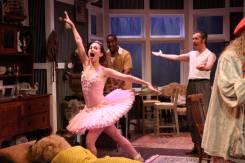

For the uninitiated, You Can’t Take It With You recounts the tale of the charmingly eccentric Vanderhoff/Sycamore clan, a multigenerational family residing together in perfect, if oddball, harmony in a large New York City home. Grandpa Martin quit Wall Street decades ago because he “wasn’t having any fun.” His daughter Penny writes plays because a typewriter was delivered to their house by mistake eight years ago. Granddaughter Essie longs to be a dancer even though her Russian émigré ballet instructor Mr. Kolenkhov opines that “she stinks.” Penny’s husband Paul and lodger Mr. De Pinna make fireworks in the basement while Essie’s husband Ed plays the xylophone and delivers his wife’s homemade candies (called “Love Dreams”) with hand-printed circulars inside. (The circulars feature quotes by Trotsky proclaiming that “God is the state, the state is God,” not because Ed believes in them but because the words are short and easy to print.) African-American maid Rheba cooks meals of “cornflakes and some kind of meat,” while her unemployed boyfriend Donald is out catching flies to feed to the family’s pet snakes.
Just as Marilyn Munster was the only “normal” one in her family, so too does Alice Sycamore stick out like a sore thumb in the Vanderhoff/Sycamore home. Lovely Alice, who has a humdrum day job working for a Wall Street banker, has fallen in love with his handsome son Tony. As much as Alice loves her family, she is equally embarrassed by them, and wants Tony to get to know them “in small doses.” When Tony and his parents arrive for a painstakingly planned dinner party at the Sycamore’s on the wrong night, the stuffy Mr. Kirby and his oh-so-proper wife Miriam are in for an evening of surprises.
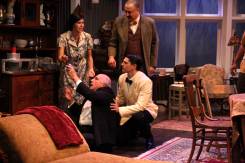
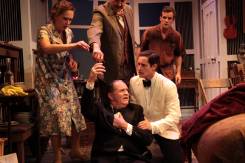 Completing the cast of characters are IRS man Wilber C. Henderson, who sets one plot thread in motion when he shows up to inform Grandpa that he owes about twenty years back income tax; Gay Wellington, the actress/lush Penny invites home to read one of her plays; Mr. Kolenkhov’s friend The Grand Duchess Olga Katrina, a Russian émigré who works as a waitress at Childs; and a trio of G-Men none too happy about the circulars Ed’s been placing in Essie’s candy boxes.
Completing the cast of characters are IRS man Wilber C. Henderson, who sets one plot thread in motion when he shows up to inform Grandpa that he owes about twenty years back income tax; Gay Wellington, the actress/lush Penny invites home to read one of her plays; Mr. Kolenkhov’s friend The Grand Duchess Olga Katrina, a Russian émigré who works as a waitress at Childs; and a trio of G-Men none too happy about the circulars Ed’s been placing in Essie’s candy boxes.
As in previous Antaeus productions, the company has brought together Company Members, younger A2 Ensemble Members, and Guest Artists and divided them into two casts, dubbed here the Kirbys and the Sycamores, with members of one cast or the other filling in for performers whenever film/TV or other work might necessitate a night or matinee off. A month of rehearsals involving all thirty-five actors gets followed by two weeks during which the two casts rehearse separately, the better to hone performances and to nuance interplay with castmates in the home stretch towards Opening Nights.
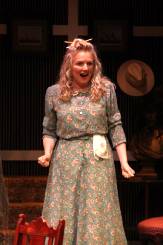

The dueling casts are, by very definition, decidedly distinct, and given the quality of talent involved, equally worth seeing. Many theatergoers will elect to see both casts as I did, and to add to the realm of possibilities, members of each cast appear together in assorted computer-picked 50/50 combinations (called the Vanderhoffs) on Thursdays and Fridays.
Directing both Sycamores and Kirbys is Antaeus treasure (and multiple Scenie-winning actress) Gigi Bermingham, who has been with the project since A2 Ensemble member Jeff Doba first suggested it two years ago, and who has approached the Kaufman and Hart classic as if it were a brand new play, which in her sparklingly fresh interpretation (make that interpretations plural) it often seems to be. (Her division of the three-act original into a more contemporary two-acter ends the now longer Act One with a bang!)
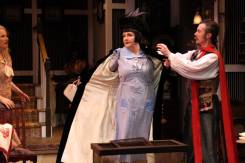
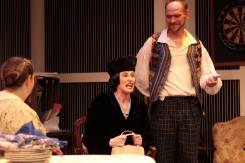
Amongst “The Sycamores,” Eve Gordon’s bohemian Penny is fresh, spontaneous, cute, and quirky—and utterly real in her more serious moments. Kellie Matteson’s zestful Essie dances like a cross between Anna Pavlova and Martha Graham, if neither one had been talented. Paul Edding makes Paul the quintessential salt-of-the-earth nice guy, Veralyn Jones’ Rheba may well be the smartest one in the house, and John Wesley’s crotchety Donald may well be too. Jeremy Guskin turns Mr. De Pinna into a curly-haired Italian pixie, while Ryan Vincent Anderson gives his sweet, simple, sincere Ed a heart of gold. As Martin, Lawrence Pressman is the wise, wry, down-to-earth Grandpa any grandchild might wish for. Kate Maher makes her passionate, patrician Alice the heart and soul of the play. As Tony, Nicholas D’Agosto gives us not only someone who has likely shone brightly all his life but is a dashing, multidimensional hero to boot. Jeremy Shouldis’s Henderson gets every laugh imaginable in his brief scene. Jacob Sidney gives Kolenkhov a big booming baritone and body language to match. John Apicella makes Mr. Kirby far more than a mere wealthy banker stereotype, opposite whom Amelia White’s Mrs. Kirby has a delicious way with lines, both vocally and facially, and her return as the Grand Duchess is full of Russian Joie De Vivre. Rhonda Aldrich’s Gay Wellington may have spent more time in burlesque than on Broadway, or at least so the bawdy song she substitutes for Gay’s usual limerick would suggest. Special guest Phil Proctor is a take-charge G-Man abetted by Caleb Chomer as Jim and Shouldis as Mac.
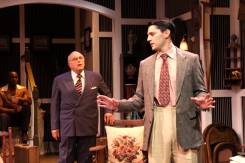
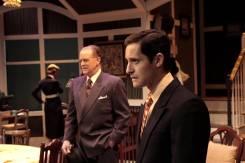
Then there are “The Kirbys,” Lizzie Zerebko gives us a bubbly, sunny, and oh-so charming Alice opposite Jeremy Glazer’s honest, straightforward, warm-hearted Tony, who not only looks like he could be Josh Clark’s son, but whose Act Two confrontation with Clark (as an intense, edgy, complex Mr. Kirby) proves particularly powerful. As for Shannon Holt, the reactions written on Mrs. Kirby’s patrician face are worth a thousand words each, and the same can be said for her wisecracking Grand Duchess. Project initiator Doba gives Mr. Kolenkhov a nutty flamboyance that matches Linda Park’s loopy Essie (who appears to have created her own wacko world amidst a bunch of eccentrics). Michael Hyland’s Ed has a winning combination of sincerity and affability. Larry Bates’ feisty Donald and Karen Malina White’s sassy Rheba pay homage to 1930s legends like Eddie ‘Rochester’ Anderson and Butterfly McQueen. Janellen Steininger’s turns Gay Wellington into a Katharine Cornell wannabe whose salty limerick scores one of the evening’s biggest laughs. Venerable thespian Joseph Ruskin makes for a crusty yet wise and loveable Grandpa, Tony Abatemarco’s zesty Mr. De Pinna may share Essie’s roving eye for his fellow men, and Marcelo Tubert turns Paul into a peppy cross between Keenan Wynn and John Astin. In Julia Fletcher’s hands, the ditzy Penny becomes a devoted earth-mother hen with absolutely no social filter. Patrick Wenk-Wolff’s Wilber Henderson is an IRS man you wouldn’t want to tangle with unless you kept snakes in the living room (which the Sycamores do), and he returns with David Glasser’s Jim and a special guest as The G-Man (an appropriately zealous Raphael Sbarge on Opening Night).
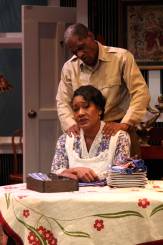
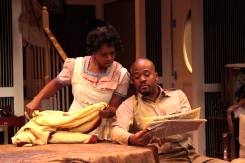
There may have been larger-scale local productions of You Can’t Take It With You in years past (the 2005 Geffen Playhouse revival certainly was), but it’s doubtful any have been more lovingly, meticulously, and creatively designed than this one, beginning with Tom Buderwitz’s gorgeously cluttered set, which manages to squeeze the Vanderhoff abode onto the relatively tiny Deaf West Theatre stage and still have room for more than a dozen characters at once. Properties designer Heather Ho shares credit for the set’s attention to detail, with mementos of decades spent sharing a family home hung, set, and strewn throughout. A. Jeffrey Schoenberg’s 1930s costumes are splendid each and every one, not only proving period-perfect but reflecting the personalities of both characters and (double-cast) performers as well. Jeremy Pivnick’s expert lighting design not only enhances the look of set, props, and costumes, but features several lovely effects as well. Jeff Gardner’s sound design sets the mood with appropriately ‘30s music choices and a whole lot of explosions. Gil Tordjman is stage manager.
Three-quarters of a century may have passed since Broadway (and the world) first discovered You Can’t Take It With You, but none of the intervening years have taken away an iota of its charm. As for its celebration of non-conformity and message of Carpe Diem, each remains as relevant, powerful, and entertaining in 2012 as they did in 1936. Only a very crowded calendar prevents this reviewer from paying return visits to the Kirbys and the Sycamores or from sampling several different Vanderhoff combinations, the highest praise I can offer to what seems likely to be the year’s very best classic comedy revival.
The Antaeus Company, Deaf West Theatre, 5112 Lankershim Blvd., North Hollywood.
www.Antaeus.org
–Steven Stanley
October 18 and 19, 2012
Photos: Geoffrey Wade/Karianne Flaathen
(Sycamores on the left, Kirbys on the right)


 Since 2007, Steven Stanley's StageSceneLA.com has spotlighted the best in Southern California theater via reviews, interviews, and its annual StageSceneLA Scenies.
Since 2007, Steven Stanley's StageSceneLA.com has spotlighted the best in Southern California theater via reviews, interviews, and its annual StageSceneLA Scenies.







 COPYRIGHT 2024 STEVEN STANLEY :: DESIGN BY
COPYRIGHT 2024 STEVEN STANLEY :: DESIGN BY